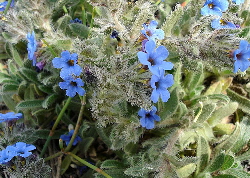|
True Alkanet (Alkanna tinctoria or Alkanna matthioli)

Alkanet can refer to two different plants of the borage family and there is often some confusion in the literature as to which is being used. Alkanna tinctoria is the true alkanet and its thick, fleshy red-maroon roots produce a purple or red dye used in textiles and soap.
1. Biology of alkanet
2. Cultivation of alkanet
3. Dyeing with alkanet
4. Dyeing wool with alkanet
5. Dyeing cotton with alkanet
6. False alkanet (opens new page)
1. Biology of Alkanet
Alkanet is a perennial herb and a native to Southern Europe. Unlike false alkanet which grows as a tall bush, true alkanet sprawls on the ground. It has small blue flowers and grey-green leaves.
2. Cultivation of Alkanet
Alkanet seeds are very fine and difficult to germinate. Both plants and seeds are hard to source. Alkanet needs a warm and dry climate to grow, thriving on sandy soils.
3. Dyeing with Alkanet
The alkanet dye, Alkannin, produced from dried alkanet roots, produces lavender and purple colours when simmered in water. It is not very soluble in water and the colour can fade with washing or overexposure to sunlight.
4. Dyeing Wool with Alkanet
Soak 100 grams of alkanet in water for at least a week. Simmer the roots in water for an hour in a ventilated area, as the roots can produce an unpleasant smell. Strain the dye liquor, add 100 grams of mordanted wool and simmer for another hour.
5. Dyeing Cotton with Alkanet
Follow the same procedure as for dyeing wool but add a teaspoon or two of soda ash to raise the pH. This makes the alkanet more soluble (a high pH can damage wool, but not cotton).
A more expensive alternative is to soak the roots in cheap rum or gin, rather than water, for a couple of weeks as this helps to extract the pigment. Make sure you mark the container clearly with ‘do not drink’. You can then dilute this well with water, simmer for an hour and then add mordanted wool or cotton.
Alkanet is also used in soap making as the pigment dissolves better when steeped in oils. The resulting colour depends on the pH of the soap and concentration of alkanet and varies from pale lavender to purple.
Top of page
|